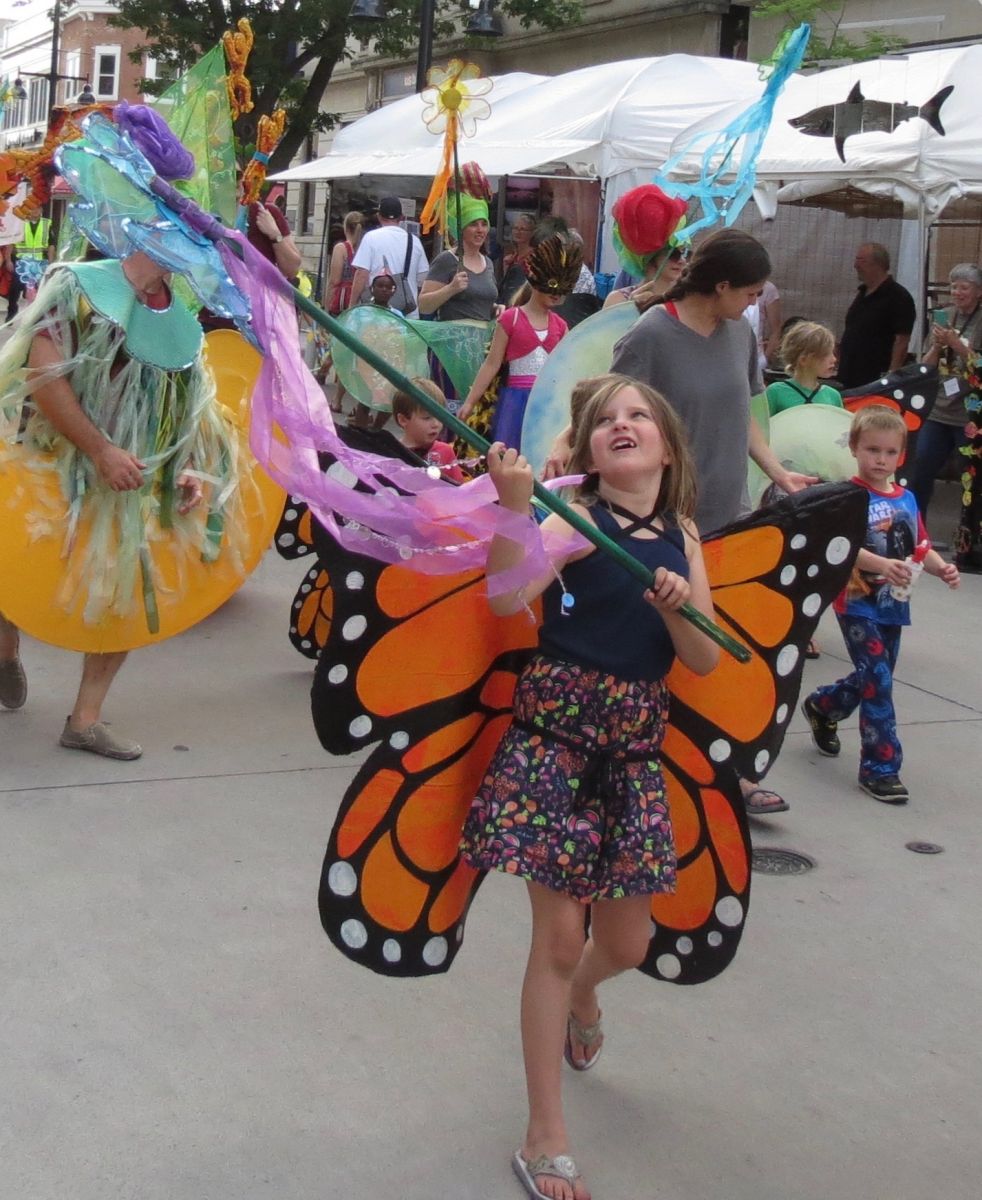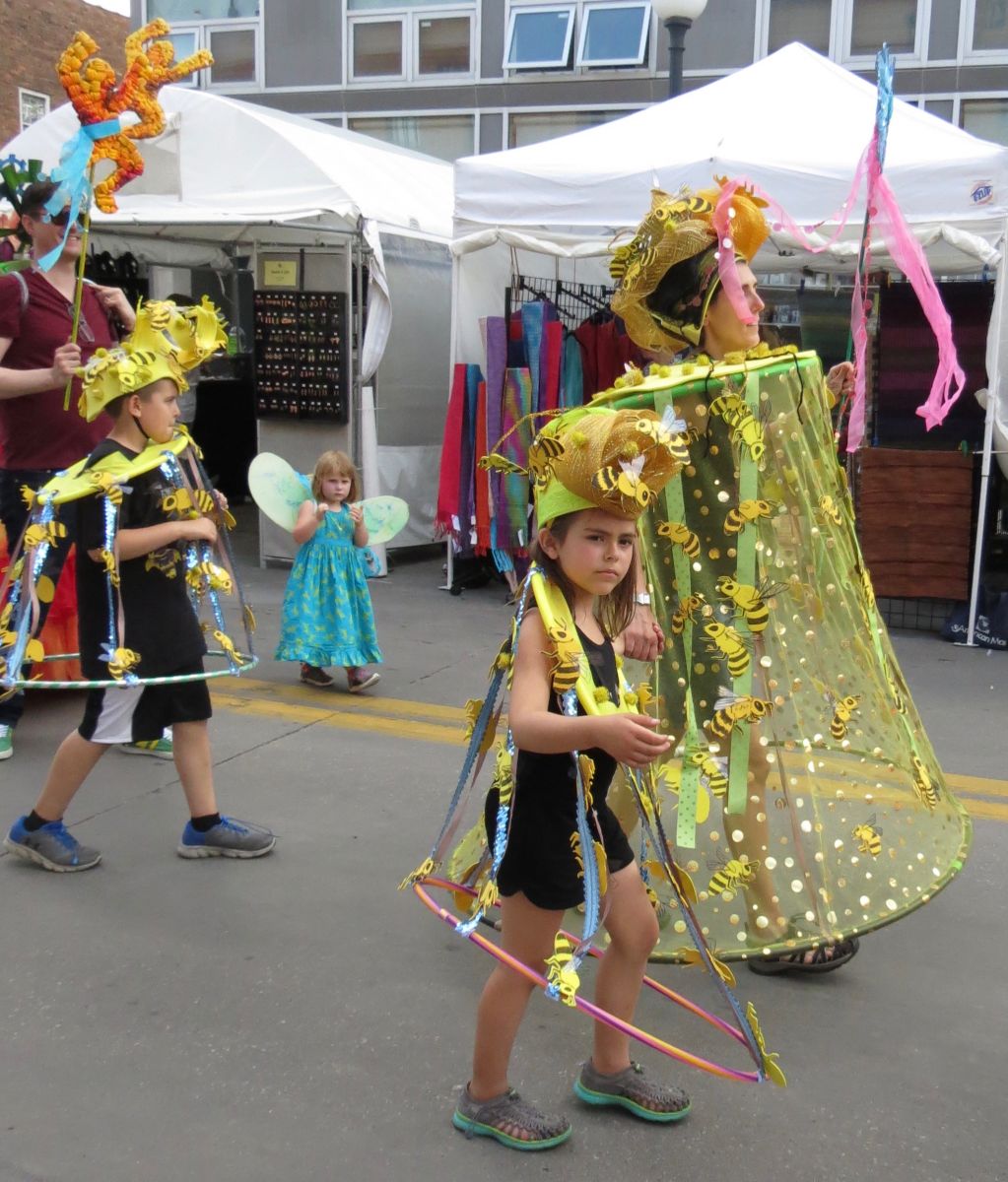 Traveling through the air past Afro Brazilian drum beats, the June breeze settled on a set of hand-painted butterfly wings, which fluttered gently on the back of 7-year-old Karina Schularick. In the 86 degree heat, she modeled the orange and black of her monarch costume before Iowa City’s Brazilian- and Caribbean-style carnival parade.
Traveling through the air past Afro Brazilian drum beats, the June breeze settled on a set of hand-painted butterfly wings, which fluttered gently on the back of 7-year-old Karina Schularick. In the 86 degree heat, she modeled the orange and black of her monarch costume before Iowa City’s Brazilian- and Caribbean-style carnival parade.
“I’ve never been in a parade before,” she said. She flapped her arms a little. “I really like the wings.”
In her monarch costume, Karina became a part of something bigger than herself. By walking in the parade that kicked off Iowa City’s Arts Festival on June 2, she became immersed in a community arts tradition, a rich display of kinetic art that included storytelling, dance, visual art, and more.
Now in its fourth year, the parade celebrated community with a theme of “Iowa Stories.” For instance, monarch butterfly and bee costumes signified the importance of pollinators to the Iowa environment. And colorful floral gears represented the state’s intertwined natural and industrial worlds, said Loyce Arthur, associate professor of design in the University of Iowa Department of Theatre Arts and organizer of the carnival parade project.
Though Mardi Gras is well-known in the United States, less Americans are familiar with the Pre-Lenten tradition of carnival, which has its roots in European festivals and African rituals. Carnival in major cities like Port of Spain, Trinidad and Tobago and Rio de Janeiro, Brazil are a blend of traditions native to those countries as well as traditions carried over during a time of French, Spanish, British, and Portuguese colonization as well as the Middle Passage slave trade. Over time, carnival reflected the changes in Brazil and the Caribbean culture—including slave emancipation, national independence, and civil rights movements. 
People walking and celebrating together, especially in fun, vibrant costumes, creates a sense of oneness and community, Arthur said.
“In an increasingly technological and impersonal world, the carnival arts are utilized to bridge differences, build community, and celebrate human resilience and creativity in Iowa City,” Arthur wrote in a description of the project.
Iowa City-area artists and art enthusiasts were invited to participate on an individual or group basis. Many high school and UI students participated, too. And all ages, from children in strollers to seniors, have been involved. The goal of this community arts tradition is to involve as many members of the UI and Iowa City community as possible, Arthur said. Along with the 40 or so people who walked in the parade, others in the community participated by decorating the parade’s bee costumes, new this year, on the Pedestrian Mall last month.
Just before the parade, a no-experience-required percussion workshop was held. Minneapolis-based Afro Brazilian drummer Troy Wilson taught basic drumming techniques to participants who went on to drum in the parade.
 Paradise Murphy, 12, attended the percussion workshop with her father. She played an agogo bell, a percussion instrument of African origin.
Paradise Murphy, 12, attended the percussion workshop with her father. She played an agogo bell, a percussion instrument of African origin.
“I just learned it today,” Paradise said, taking a brief break from striking the bell with a drum stick. When she resumed, its cowbell-like sound carried through the air, mingling with drums and a variety of other instruments practiced by the new percussionists.
Dance Professor Armando Duarte, who choreographed a dance for parade participants last year, said carnival is a joyful celebratory experience.
“It’s the idea of becoming—if I wear a costume, I have license to become the art,” he said.
Duarte, who was born in Brazil and is personally familiar with the carnival culture, said carnival is about a joy of movement and celebration. This is especially important for children, he said, as all those in costume are equal, moving as one.
That oneness is an important theme of carnival, Arthur said.
“When people from all different backgrounds celebrate together, that might lead to other types of partnerships and to learning what we all have in common,” Arthur said. “A carnival parade won’t change the world, but I hope it brings people together on multiple levels.”
The carnival parade will be part of the 2017 UI Homecoming Parade in October. To participate and wear a costume, contact loyce-arthur@uiowa.edu.
Visit the Iowa City Community Carnival Parade Project on Facebook and Twitter.